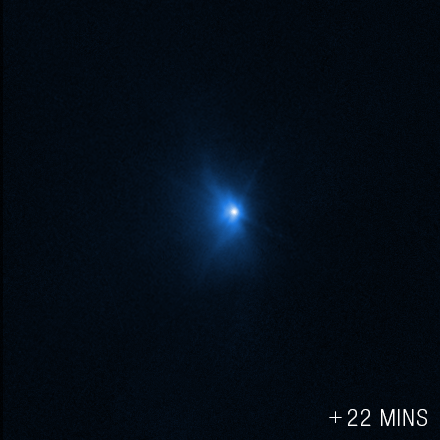Earth From Another Sun offers a Starfield- and Halo-inspired approach to a space-based, first-person shooter.
Space News & Blog Articles
A Dwarf Galaxy Passed Close to the Milky Way and Left Ripples in its Wake
When you imagine the collision of galaxies, you probably think of something violent and transformational. Spiral arms ripped apart, stars colliding, cats and dogs living together, mass hysteria. The reality is much less dramatic. As a recent study shows, our galaxy is in a collision right now.
Although the big collision between the Milky Way and the Andromeda Galaxy is still yet to come, our galaxy has undergone galactic collisions in the past. The most well-understood collision is that between the Milky Way and the Sagittarius Dwarf Galaxy. This small galaxy first impacted the Milky Way about 6 billion years ago and may have triggered the star-forming period that produced our Sun.
History of the Sagittarius dwarf galaxy collision. Credit: ESABut collisions on a galactic scale are slow and tedious. Over billions of years, the core of the Sagittarius galaxy has struck the Milky Way a few times as it is gradually ripped apart. It can now be seen as arcs of stars encircling our galaxy. It stands to reason that such an ancient collision is long over, but this recent study shows it still has ripple effects on the Milky Way. Literally.
The team used data from the Gaia spacecraft and looked at the motion of stars near the outer edge of the Milky Way. The velocities of these stars showed a rippled distribution of motion, created by Sagittarius the way a dropped stone might trigger ripples on a pond. Overall the stars at the outer edge of the Milky Way are not in gravitational equilibrium, which is a fancy way of saying our galaxy is still feeling the effects of the collision.
The team was surprised by the level of detail the Gaia data provided. By measuring the positions of more than two billion stars, and the motions of more than 30 million, Gaia has given the team a kind of galactic seismology that can be used to trace the dynamic history and evolution of the Milky Way.
Why are sunspots black?
Why are sunspots black? According to astronomers, it may be a big, cosmic optical illusion.
Stars Spiral Inward to the Cores of Stellar Nurseries
Astronomers studying a stellar cluster within the Small Magellanic Cloud (SMC) have found young stars spiraling in towards the center of the cluster. The cluster, NGC 346, is an open cluster embedded within a glowing cloud of gas, which is typical of stellar nurseries – places where new stars are formed. The outer spiral arm of this star forming region appears to be funneling gas, dust and new stars into the center, which researchers describe as an efficient way to fuel the birth of new stars.
The SMC is a small satellite galaxy of the Milky Way, visible with the naked eye to Southern hemisphere observers under dark skies. It is about 200 000 light years away, and contains a number of nebulae and clusters. One of these, NGC 346, combines a population of bright, new stars, and their still-collapsing stellar nursery of gas and dust, which continues to produce new stars.
The region is only 150 light years across, and has a mass of about 50 000 Suns. Its unusually high rate of star-formation, and its intriguing shape, have been an interesting puzzle to astronomers for some time. This latest image offers some fresh clues to help us understand what’s going on. It combines observations from the Hubble Space Telescope (HST) and the European Southern Observatory’s (ESO) Very Large Telescope (VLT).
NGC 346: Star Forming Cluster in the SMC. Image Credit & License: NASA, ESA, Hubble; Processing: Judy SchmidtElena Sabbi of the Space Telescope Science Institute in Baltimore, and leader of the study, had this to say:
“Stars are the machines that sculpt the Universe. We would not have life without stars, and yet we don’t fully understand how they form. We have several models that make predictions, and some of these predictions are contradictory. We want to determine what is regulating the process of star formation, because these are the laws that we need to also understand what we see in the early Universe.”

3D sky: How astronomers measure the size, luminosity and distance of stars
Stars differ in size, luminosity and distance from us. We discuss how astronomers measure these three values to understand the three-dimensional sky.
See the crescent moon shine above the red star Antares tonight (Sept. 30)
The brightest star in the constellation of Scorpius, Antares will appear below the moon on Friday evening.
Behold! Our closest view of Jupiter's ocean moon Europa in 22 years
NASA's Juno spacecraft skimmed close above the surface of icy Europa Thursday (Sept. 29), capturing a view of the crust that is just the start of our new study of this ocean world.
Moon science generation
Image:
What do you call three or more space fanatics? Interns.
Imagine landing your dream internship at the European Astronaut Centre (EAC), and then being unable to go into work. A group of excellent young professionals found themselves in this situation during the pandemic.
This week, however, 23 of these interns finally got their opportunity to visit the home of Europe’s Astronaut corps. The interns had been working on a range of projects developing tools to support astronaut training for missions to the Moon and beyond. Upon visiting, they were immediately immersed in the centre’s activities.
The group, imaged here logging data into the Electronic Field Book (EFB), experienced some of the geological training activities the centre provides. In dedicated sessions, armed with spectrometers, drawing booklets, microscopes and the appropriate clothing, the interns had to exercise rock recognition through the EFB, characterise samples, and provide feedback.
This geological experience was modelled off of ESA’s Pangea training course, a balanced mix of theory and field trips designed to hone astronauts’ geology skills. This year’s course with ESA astronaut Alexander Gerst and NASA astronaut Stephanie Wilson began earlier this month in the Italian Dolomites with lessons on fundamental geology knowledge and skills, and will continue in the volcanic landscapes of Lanzarote next month.
Europe’s new weather satellite sets sail
The first of Europe’s Meteosat Third Generation satellites is now safely aboard a ship and making its way across the Atlantic to French Guiana where it will be readied for liftoff in December. Once launched into geostationary orbit, 36 000 km above Earth, this new satellite, which carries two new extremely sensitive instruments, will take weather forecasting to the next level.
This Week's Sky at a Glance, September 30 – October 8
The Moon poses with Antares at dusk. A few nights later, lunar sunrise unveils the sharp black line of the Straight Wall in Mare Nubium for small-telescope users. Saturn, Jupiter, and Mars span the evening sky. Mercury climbs onstage at dawn.
The post This Week's Sky at a Glance, September 30 – October 8 appeared first on Sky & Telescope.
Firefly Aerospace aborts orbital test flight just after engine ignition
Firefly planned to send its Alpha rocket to orbit on a test flight early Friday morning (Sept. 30), and it ticked off a lot of boxes along the way — including engine ignition.
Earth from Space: Melt ponds in West Greenland
During spring and summer, as the air warms up and the sun beats down on the Greenland Ice Sheet, melt ponds pop up. Melt ponds are vast pools of open water that form on both sea ice and ice sheets and are visible as turquoise-blue pools of water in this Copernicus Sentinel-2 image.
New weather satellite on its way to launch
Video: 00:04:04
The final pre-launch preparations for the first Meteosat Third Generation (MTG) satellite are underway. The first satellite, called MTG-I1, built by a European industrial consortium led by Thales Alenia Space carries two imagers: an advanced Flexible Combined Imager and, in a first for Europe, a Lightning Imager that will allow the earlier detection of storms and extreme weather events, as well as improve aviation safety.
Building on the long-standing partnership between ESA and Eumetsat, the MTG-I1 will be one of six satellites operating in a fleet, of three at a time, to ensure the continuity of data from the previous Meteosat satellites over the next 20 years. The first Meteosat was launched in 1977 and this third generation of spacecraft will be the most advanced yet, with improved image resolution and providing close to real time data for users, or ‘nowcasting’ of fast-developing, high-impact weather.
The launch is currently scheduled for the end of 2022.
The film includes soundbites from ESA Director of Earth Observation Programmes: Simonetta Cheli, ESA Meteosat Programme Manager: Paul Blythe, ESA Meteosat Third Generation Payload Manager: Donny Aminou and EUMETSAT, Meteosat Third Generation Programme Manager: Alexander Schmid.
Mysterious Europa Gets an Extreme Closeup From NASA’s Juno Probe
Over the course of a brief two-hour opportunity, NASA’s Juno spacecraft captured a rare close look at Europa, an ice-covered moon of Jupiter that’s thought to harbor a hidden ocean — and perhaps an extraterrestrial strain of marine life.
Juno has been orbiting Jupiter since 2016, but this week brought the best opportunity to look at Europa, which is the prime target for investigation by NASA’s Europa Clipper probe in the 2030s. On Sept. 29, the orbiter buzzed over the moon’s surface at a velocity in excess of 52,000 mph (23.6 km per second), and at an altitude of 352 kilometers (219 miles).
That’s as close as any spacecraft has come to Europa since the Galileo orbiter’s 218-mile flyby in 2000.
This image from NASA’s Juno spacecraft shows an area of Europa’s surface north of the equator. The prominent pit seen in the lower half of the image might be a degraded impact crater. (NASA / JPL-Caltech / SwRI / MSSS)The spacecraft’s JunoCam imager is designed mostly for public engagement purposes — and over the past six years, image-processing fans have helped NASA bring stunning pictures of Jupiter to the public. Now they’re doing much the same for JunoCam’s photos of Europa.
In the first image sent back by the spacecraft, focusing on an area near Europa’s equator known as Annwn Regio, you can make out the trademark ridges and troughs of Europa’s icy shell. The cracks in the ice are thought to be caused by the tidal forces that are generated as Europa orbits Jupiter.
The Moon was Pummeled by Asteroids at the Same Time the Dinosaurs Died. Coincidence?
It only takes a quick look at the Moon to see its impact-beaten surface. There are craters everywhere. Some of those impact sites apparently date back to the same time some very large asteroids were whacking Earth. One of them formed Chixculub Crater under the Yucatan Peninsula. That impact set in motion catastrophic events that wiped out much of life on Earth, including the dinosaurs.
Did some of the craters on the Moon form from the same asteroid swarm that impacted Earth and precipitated the demise of the dinosaurs? Chang’e 5 samples from specific craters on the Moon seem to show that this could well have happened.
That’s the conclusion a group of Australian scientists came to after studying glass beads from the Moon. They outlined their findings in a paper about the science they performed on samples picked up from the Moon by the Chang’e 5 Lunar mission. The beads were created by the heat and pressure caused by meteoritic impacts on the Moon. The lead author of the paper, Professor Alexander Nemchin, from Curtin University’s Space Science and Technology Centre (SSTC) in the School of Earth and Planetary Sciences, said the findings imply that the timing and frequency of asteroid impacts on the Moon may have been mirrored on Earth. If so then the find tells us more about the history of the evolution of our own planet.
“We combined a wide range of microscopic analytical techniques, numerical modeling, and geological surveys to determine how these microscopic glass beads from the Moon were formed and when,” Professor Nemchin said. “We found that some of the age groups of the lunar glass beads coincide precisely with the ages of some of the largest terrestrial impact crater events, including the Chicxulub impact crater responsible for the dinosaur extinction event.”
Glass beads collected by the Chang’e 5 mission date back some 66 million years and could have formed from impacts. Courtesy Beijing SHRIMP Center, Institute of Geology, CAGS
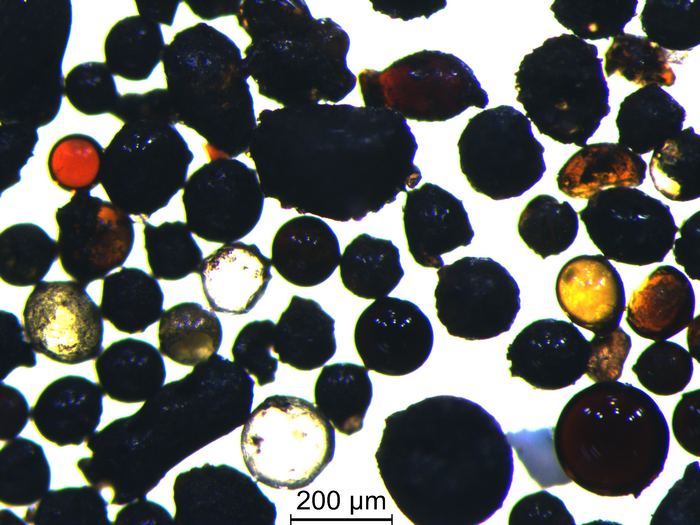
Live coverage: Firefly ready for middle-of-the-night launch from California
Live coverage of the countdown and launch of Firefly’s Alpha rocket on the “To the Black” test flight with seven small nanosatellites and picosatellites. Text updates will appear automatically below; there is no need to reload the page. Follow us on Twitter.
Video credit: Everyday Astronaut / Firefly Aerospace
SpaceX, NASA look at launching Dragon to service Hubble Space Telescope
Astronauts could visit the Hubble Space Telescope again someday, this time on a SpaceX Dragon.
SpaceX, NASA studying commercial crew mission to Hubble Space Telescope
The Hubble Space Telescope in the payload bay of space shuttle Atlantis during the last servicing mission in May 2009. Credit: NASA
NASA and SpaceX will study the potential use of a commercial Dragon crew spacecraft to reboost and service the Hubble Space Telescope, a 32-year-old observatory last upgraded by a space shuttle in 2009, officials announced Thursday.
The study will explore the the technical feasibility of using a SpaceX Dragon spacecraft to dock with Hubble, currently orbiting more than 330 miles (530 kilometers) above Earth. Once docked, the Dragon capsule’s propulsion system could raise Hubble’s altitude to delay the telescope’s eventual re-entry back into the atmosphere. Engineers will also examine ways to use the Dragon spacecraft with astronauts to service Hubble.
“A few months ago, SpaceX approached NASA with the idea for a study whether a commercial crew could help reboost our Hubble spacecraft into a higher orbit, one that would extend its additional lifetime,” said Thomas Zurbuchen, head of NASA’s science mission directorate. “Today, we’re announcing that we have signed a Space Act Agreement with SpaceX to produce a feasibility study of exactly that, as well as some other tools that may be coming to bear, really what the benefits and risks would be to having a private team help support one of NASA’s science missions.”
Hubble launched on NASA’s space shuttle Discovery in April 1990, and was designed for servicing in orbit. Five more space shuttle missions upgraded, repaired, and reboosted Hubble, fixing the telescope’s blurred vision and adding new science instruments. The last servicing mission was in 2009, and NASA retired the space shuttle fleet in 2011 after completing assembly of the International Space Station.
There’s no guarantee the six-month feasibility study will lead to a mission to Hubble.
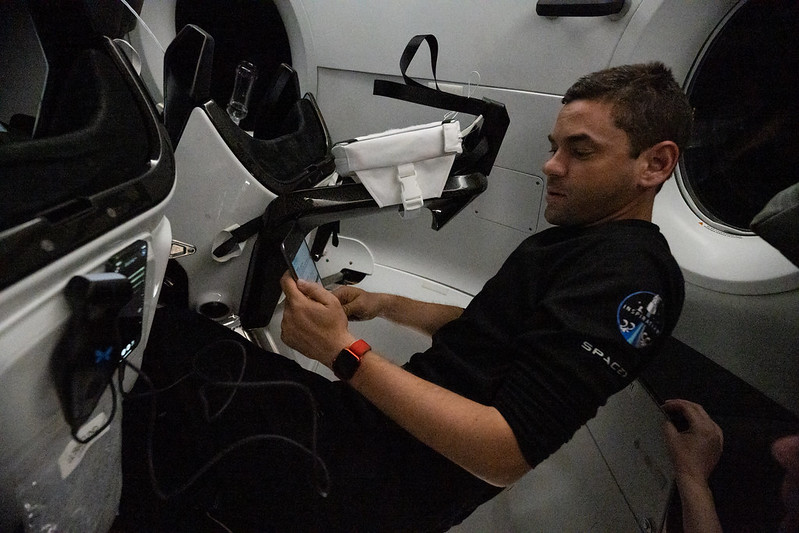
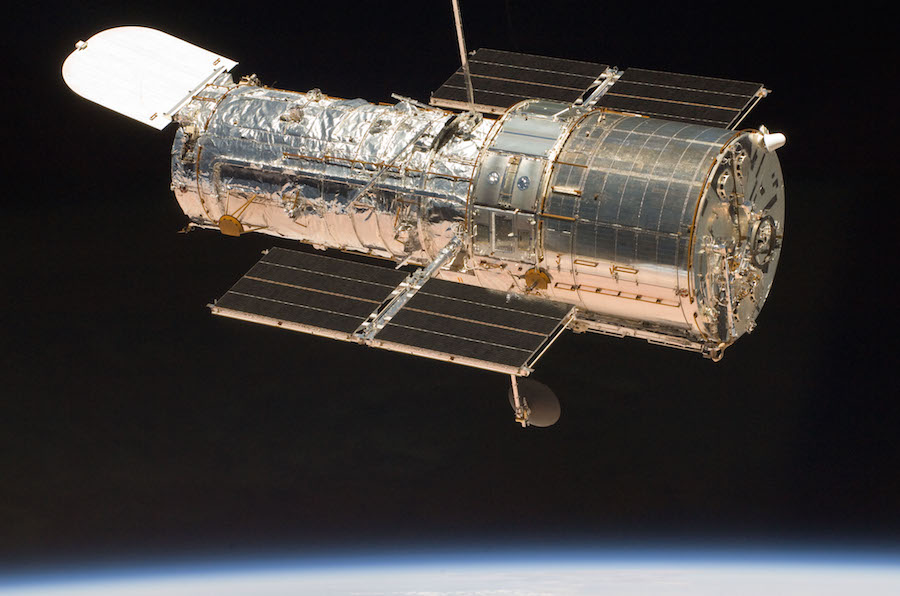
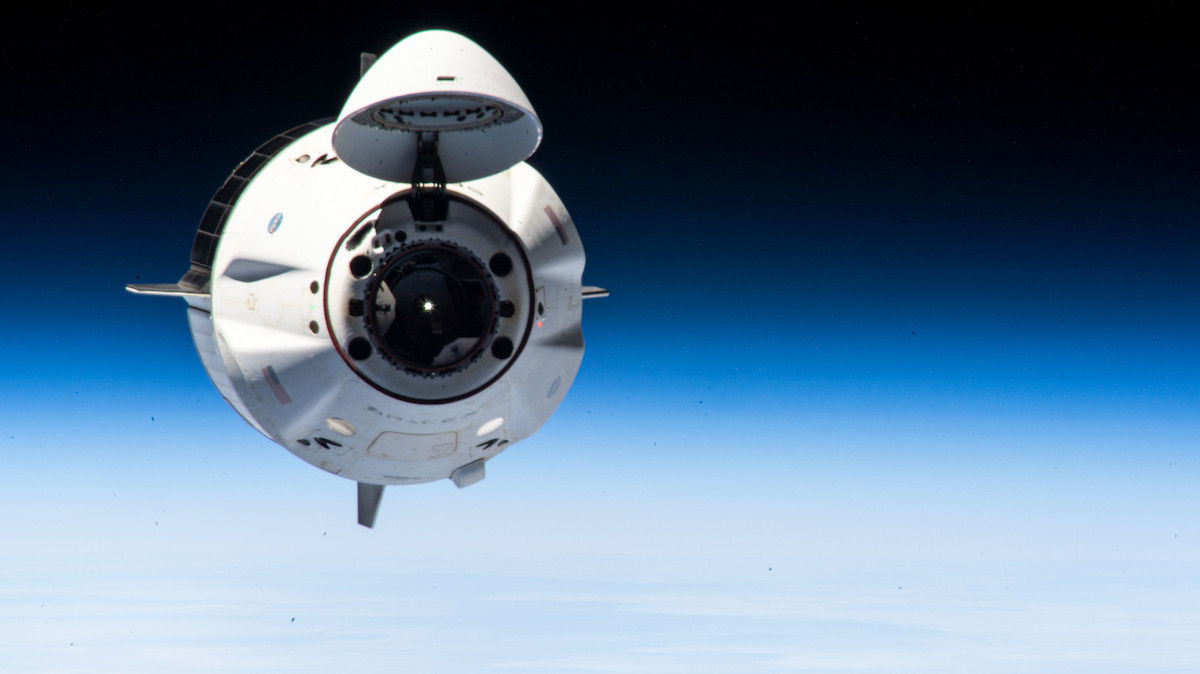
DART Impact Seen by Hubble and Webb
What happens when you whack a little asteroid with an even littler spacecraft? People around the world watched on the 26th of September when the DART mission smashed into the side of Dimorphos. This tiny worldlet is a companion asteroid to Didymos. It was the world’s first test of the kinetic impact technique, using a spacecraft to deflect an asteroid by modifying its orbit. Amateur observer networks and professional observatories tracked the meetup from the ground. In a first, both Hubble Space Telescope (HST) and the James Webb Space Telescope (JWST) took simultaneous images and data.
Together, they managed to track the asteroid before the event. Then, they got images and data about the ejecta (the material that got flung away from it) afterward. Each set of images showed streaks of ejecta stretching out away from the little asteroid. Scientists could even tell exactly where the spacecraft hit the asteroid. The data should tell them about the asteroid’s composition and structure. Eventually, they should find out how much the impact affected Dimorphosis’s orbit.
Doin’ it with DART
The collision of spacecraft and an asteroid posed a challenge for observers. That’s because Dimorphos and its companion Didymos move fairly quickly in their orbits. Ground-based observers were able to track the faint objects fairly well, and networks of smaller telescopes caught a view of the collision and its aftermath.
For JWST, tracking that action isn’t exactly what the telescope was built for, but the teams managed. Flight operations, planning, and science teams for JWST had to come up with a method to track the asteroids. They actually move faster than JWST was originally programmed for, so that had to be taken into account. JWST watched the event using its Near-Infrared Camera (NIRCam). Webb observed the impact over five hours total and captured 10 images.
JWST captured this sequence of the DART collision on Dimorphos. Courtesy NASA, ESA, CSA, and STScI.
